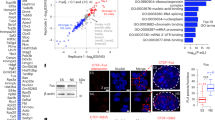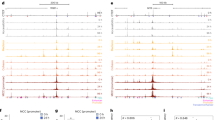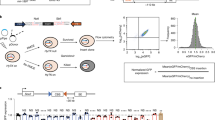Abstract
Chromatin insulators demarcate expression domains by blocking the cis effects of enhancers or silencers in a position-dependent manner1,2. We show that the chromatin insulator protein CTCF carries a post-translational modification: poly(ADP-ribosyl)ation. Chromatin immunoprecipitation analysis showed that a poly(ADP-ribosyl)ation mark, which exclusively segregates with the maternal allele of the insulator domain in the H19 imprinting control region, requires the bases that are essential for interaction with CTCF3. Chromatin immunoprecipitation–on–chip analysis documented that the link between CTCF and poly(ADP-ribosyl)ation extended to more than 140 mouse CTCF target sites. An insulator trap assay showed that the insulator function of most of these CTCF target sites is sensitive to 3-aminobenzamide, an inhibitor of poly(ADP-ribose) polymerase activity. We suggest that poly(ADP-ribosyl)ation imparts chromatin insulator properties to CTCF at both imprinted and nonimprinted loci, which has implications for the regulation of expression domains and their demise in pathological lesions.
This is a preview of subscription content, access via your institution
Access options
Subscribe to this journal
Receive 12 print issues and online access
$259.00 per year
only $21.58 per issue
Buy this article
- Purchase on SpringerLink
- Instant access to full article PDF
Prices may be subject to local taxes which are calculated during checkout




Similar content being viewed by others
References
Bell, A.C., West, A.G. & Felsenfeld, G. Insulators and boundaries: versatile regulatory elements in the eukaryotic genome. Science 291, 447–450 (2001).
Ohlsson, R., Renkawitz, R. & Lobanenkov, V. CTCF is a uniquely versatile transcription regulator linked to epigenetics and disease. Trends Genet. 17, 520–527 (2001).
Kanduri, C. et al. Functional interaction of CTCF with the insulator upstream of the H19 gene is parent of origin-specific and methylation-sensitive. Curr. Biol. 10, 853–856 (2000).
Ziegler, M. & Oei, S.L. A cellular switch: poly(ADP-ribosy)lation stimulates DNA repair and silences transcription. Bioessays 23, 543–548 (2001).
Smith, S. The world according to PARP. Trends Biochem. Sci. 26, 174–179 (2001).
Kraus, W. & Lis, J. PARP goes transcription. Cell 113, 677–683 (2003).
Tulin, A., Stewart, D. & Spradling, A. The Drosophila heterochromatic gene encoding poly(ADP-ribose) polymerase (PARP) is required to modulate chromatin structure during development. Genes Dev. 16, 2108–2119 (2002).
Thorvaldsen, J.L., Duran, K.L. & Bartolomei, M.S. Deletion of the H19 differentially methylated domain results in loss of imprinted expression of H19 and Igf2. Genes Dev. 12, 3693–3702 (1998).
Kanduri, C. et al. The 5′-flank of the murine H19 gene in an unusual chromatin conformation unidirectionally blocks enhancer-promoter communication. Curr. Biol. 10, 449–457 (2000).
Pant, V. et al. The nucleotides responsible for the direct physical contact between the chromatin insulator protein CTCF and the H19 imprinting control region manifest parent of origin-specific long-distance insulation and methylation-free domains. Genes Dev. 17, 586–590 (2003).
Yusufzai, T., Tagami, H., Nakatani, Y. & Felsenfeld, G. CTCF tethers an insulator to subnuclear sites, suggesting shared insulator mechanisms across species. Mol. Cell 13, 291–298 (2004).
Mukhopadhyay, R. et al. The binding sites for the chromatin insulator protein CTCF map to DNA methylation-free domains genomewide. Genome Res. 14, 1594–1602 (2004).
Holmgren, C. et al. CpG methylation regulates the Igf2/H19 insulator. Curr. Biol. 11, 1128–1130 (2001).
Kanduri, C., Kanduri, M., Thakur, N., Pfeifer, S. & Ohlsson, R. The kinetics of deregulation of expression by de novo methylation of the H19 imprinting control region in cancer cells. Cancer Res. 62, 4545–4548 (2002).
Kanduri, C. et al. A differentially methylated imprinting control region within the Kcnq1 locus harbours a methylation-sensitive chromatin insulator. J. Biol. Chem. 277, 18106–18110 (2002).
Horike, S. et al. Targeted disruption of the human LIT1 locus defines a putative imprinting control element playing an essential role in Beckwith-Wiedemann syndrome. Hum. Mol. Genet. 9, 2075–2083 (2000).
Sallmann, F.R., Vodenicharov, M.D., Wang, Z.Q. & Poirier, G.G. Characterization of sPARP-1. An alternative product of PARP-1 gene with poly(ADP-ribose) polymerase activity independent of DNA strand breaks. J. Biol. Chem. 275, 15504–15511 (2000).
Davidovic, L., Vodenicharov, M., Affar, E. & Poirier, G. Importance of poly(ADP-ribose) glucohydrolase in the control of poly(ADP-ribose) metabolism. Exp. Cell Res. 268, 7–13 (2001).
Constanzi, C. & Pehrson, J. Histone macroH2A1 is concentrated in the inactive X chromosome in female mammals. Nature 393, 599–601 (1998).
Allen, M., Buckle, A., Cordell, S., Lowe, J. & Bycroft, M. The crystal structure of AF1521 a protein from Archaeoglobus fulgidus with homology to the non-histone domain of macroH2A. J. Mol. Biol. 330, 503–511 (2003).
Dean, W. et al. Altered imprinted gene methylation and expression in completely ES cell-derived mouse fetuses: association with abberant phenotypes. Development 125, 2273–2282 (1998).
Franklin, G. et al. The human PDGF-B gene is regulated by cell type-specific activator and suppressor elements in the first intron. EMBO J. 10, 1365–1373 (1991).
Ohlsson, R., Holmgren, L., Glaser, A., Szpecht, A. & Pfeifer-Ohlsson, S. Insulin-like growth factor 2 and short-range stimulatory loops in control of human placental growth. EMBO J. 8, 1993–1999 (1989).
Li, Y.-M. et al. The H19 transcript is associated with polysomes and may regulate IGF2 expression in trans. J. Biol. Chem. 273, 28247–28252 (1998).
Lynch, C., Tycko, B., Bestor, T. & Walsh, C. Reactivation of a silenced H19 gene in human rhabdomyosarcoma by demethylation of DNA but not histone hyperacetylation. Mol. Cancer. 1, 2 (2002).
Chernukhin, I. et al. Physical and functional interaction between two pluripotent proteins the Y-box DNA/RNA-binding factor, YB-1, and the multivalent zinc finger factor, CTCF. J. Biol. Chem. 275, 29915–29921 (2000).
Quitschke, W.W., Taheny, M.J., Fochtmann, L.J. & Vostrov, A.A. Differential effect of zinc finger deletions on the binding of CTCF to the promoter of the amyloid precursor protein gene. Nucleic Acids Res. 28, 3370–3378 (2000).
Miranda, E., Dantzer, F., O'Farrell, M., de Murcia, G. & de Murcia, J. Characterisation of a gain-of-function mutant of poly(ADP-ribose) polymerase. Biochem. Biophys. Res. Commun. 212, 317–325 (1995).
Kanduri, M. et al. Multiple nucleosome positioning sites regulate the CTCF-mediated insulator function of the H19 imprinting control region. Mol. Cell. Biol. 22, 3339–3344 (2002).
Klenova, E. et al. CTCF, a conserved nuclear factor required for optimal transcriptional activity of the chicken c-myc gene, is an 11-Zn-finger protein differentially expressed in multiple forms. Mol. Cell. Biol. 13, 7612–7624 (1993).
Acknowledgements
We thank A. Mattsson for expert technical assistance, H. Smith and M. O'Farrell for help with the in vitro poly(ADP-ribosyl)ation assay, S. Shamsuddin for providing the domains of CTCF expressed in bacterial system, P. Hassa for helpful comments, A. Vostrov and W. Quitschke for the recombinant CTCF from Pichia and A. Isaksson and the Wallenberg microarray platform at the Rudbeck Laboratory for their assistance. This work was supported by the Swedish Science Research Council (V.R., R.O.), the Swedish Cancer Research Foundation (C.F., R.O.), the Swedish Pediatric Cancer Foundation (B.C.F., R.O.), the Lundberg Foundation (R.O.), the Wallenberg Foundation (R.O.), the Juvenile Diabetes Research Foundation International (R.O.), the Breast Cancer Campaign (F.D., E.K.), PhD Studentship from the University of Essex (D.F.), Research Promotion Fund from the University of Essex (I.C., F.D., E.K.) and the Association for International Cancer Research (I.C., E.K.).
Author information
Authors and Affiliations
Corresponding author
Ethics declarations
Competing interests
The authors declare no competing financial interests.
Rights and permissions
About this article
Cite this article
Yu, W., Ginjala, V., Pant, V. et al. Poly(ADP-ribosyl)ation regulates CTCF-dependent chromatin insulation. Nat Genet 36, 1105–1110 (2004). https://doi.org/10.1038/ng1426
Received:
Accepted:
Published:
Issue date:
DOI: https://doi.org/10.1038/ng1426
This article is cited by
-
CTCF acetylation at lysine 20 is required for the early cardiac mesoderm differentiation of embryonic stem cells
Cell Regeneration (2022)
-
Poly(ADP-ribose) Polymerase 1 (PARP1) restrains MyoD-dependent gene expression during muscle differentiation
Scientific Reports (2020)
-
Epigenetic silencing of miR-181c by DNA methylation in glioblastoma cell lines
BMC Cancer (2016)
-
CTCF: an architectural protein bridging genome topology and function
Nature Reviews Genetics (2014)
-
The DNA-binding factor Ctcf critically controls gene expression in macrophages
Cellular & Molecular Immunology (2014)



